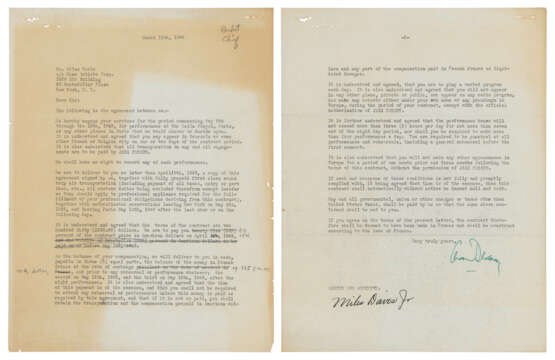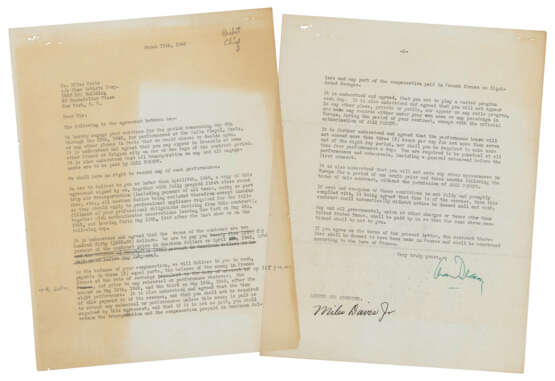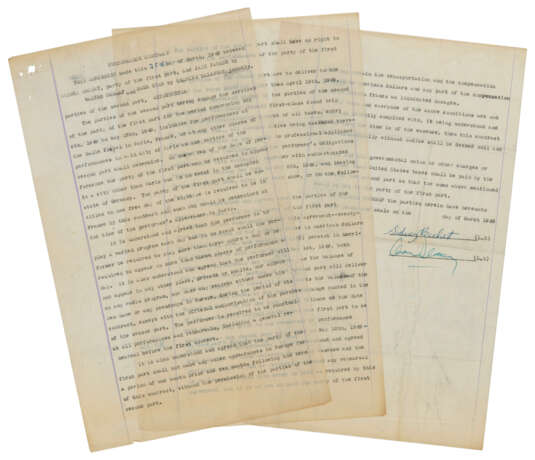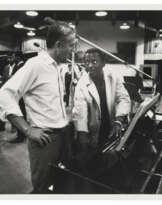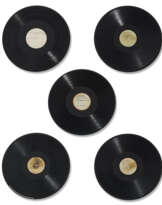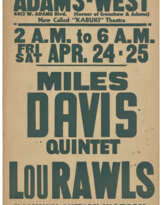ID 1029205
Los 554 | Documents signed
Schätzwert
£ 2 000 – 3 000
Two part-typescript documents signed, performance agreements for the 1949 Paris International Jazz Festival: the first an agreement between Miles Davis and festival organiser Charles Delaunay, dated 11 March 1949, signed in black ink ‘Miles Davis Jr’ and in green ink by Delaunay, the agreement engaging Miles to perform at the Salle Pleyel, Paris, and other Parisian venues from 8-15 May 1949 for a fee of $250.00; the second an agreement between headliner Sidney Bechet and Charles Delaunay, dated 25 March 1949, signed in blue ballpoint pen by Bechet and in turquoise ink by Delaunay, the agreement similarly engaging Bechet to perform from 8-15 May 1949 and specifying two down payments of $1600 – representing 25% of a total of $6400 – to the artist payable on 15 April and 1 May, with the balance due after Bechet’s arrival in Paris on 8 May; together with a supplemental typescript agreement between Bechet and his longtime friend and sometime business associate Walter Schaap, signed by both parties in blue ballpoint pen, the agreement specifying that on Bechet’s return from the Paris festival Schaap would pay him ‘the value of the French francs that Sidney Bechet shall have deposited with Charles Delauney in Paris… at the average rate of exchange of American dollars for said francs’ and stating that ‘the consideration for such exchange… is the desire for Walter Schaap to have at his disposal in France an adequate supply of francs for his overseas vacations and business engagements.’
With the appearance of Charlie Parker and Miles Davis alongside the older generation of jazz and swing musicians, as represented by Bechet, the historic festival introduced the bebop movement to European audiences. At this time, aged only 23 when he signed this contract, Miles was still just a promising young musician and this his first time abroad – as he wrote in his autobiography: ‘This was my first trip out of the country… It changed the way I looked at things forever… I loved being in Paris and loved the way I was treated.’ Davis’ total fee of $250 is notably modest compared to the $1600 down payment which Bechet received for his services at the same festival. While ostensibly providing Schaap with an ‘adequate supply of francs’ for his vacations, Bechet biographer John Chilton reveals that the Bechet-Schaap agreement was actually part of what Schaap termed a ‘necessary subterfuge’ to get around stringent French currency restrictions relating to how the musicians who performed at the festival could be paid. For the purposes of securing a work permit in spite of his previous misdemeanours, the agreement also served to demonstrate that the volatile Bechet had no intention of remaining in Paris after the festival. In the late 1920s, Bechet had been involved in a gun fight in Paris in which he accidentally shot a woman, resulting in almost a year’s imprisonment and his subsequent deportation. Bechet’s performance at the festival was so widely acclaimed and had such an impact on his popularity in France that Bechet did in fact relocate to Paris the following year, and remained there until his death in 1959.
Festival organiser Charles Delauney co-founded the Hot Club de France and Le Jazz Hot magazine, initiated the celebrated Quintette du Hot Club de France featuring Django Reinhardt and Stephane Grappelli, and wrote the first comprehensive jazz discography Hot Discography, first published in 1936 (see lot 161).
The Davis agreement two pages on onion-skin paper, signed by Miles at the foot of the second page, 277 x 214 mm; the Bechet three pages on foolscap onion-skin paper, signed by Bechet on the third page, 330 x 203 mm; the Bechet-Schaap agreement one page on foolscap onion-skin paper, 330 x 203 mm, in blue folder folding to 229 x 95 mm.
[With:] DAVIS, Miles(1926-1991). Programme for the 4me Festival International du Jazz d’Antibes Juan-les-Pins, 26-31 July 1963, signed in blue ballpoint pen by Miles Davis at his portrait and by Quintet members Ron Carter, George Coleman, Herbie Hancock and Anthony Williams on the following page, with the additional signatures of various other jazz acts showcased over the week, wire-stitched in original pictorial wraps, 268 x 213 mm.
The quintet’s performance at the festival was captured on the 1964 live album Miles in Europe, and described by Cook & Morton as ‘a very fine concert set, recorded just weeks after his band had been formed… All of the music is unpredictable and exciting, unpredictable largely because unfamiliar material is shone through a prism that mixes abstraction with genuine delight in melody.’
| Adresse der Versteigerung |
CHRISTIE'S 8 King Street, St. James's SW1Y 6QT London Vereinigtes Königreich | ||||||||
|---|---|---|---|---|---|---|---|---|---|
| Vorschau |
| ||||||||
| Telefon | +44 (0)20 7839 9060 | ||||||||
| Aufgeld | see on Website | ||||||||
| Nutzungsbedingungen | Nutzungsbedingungen |
